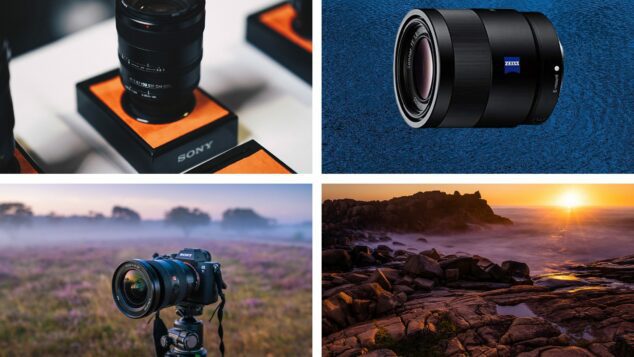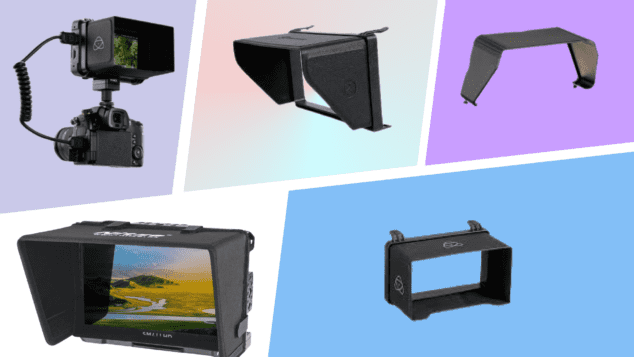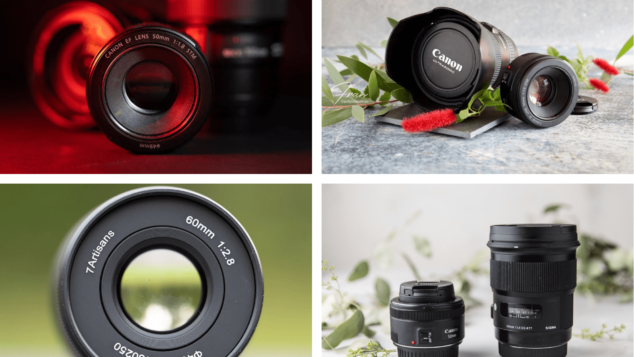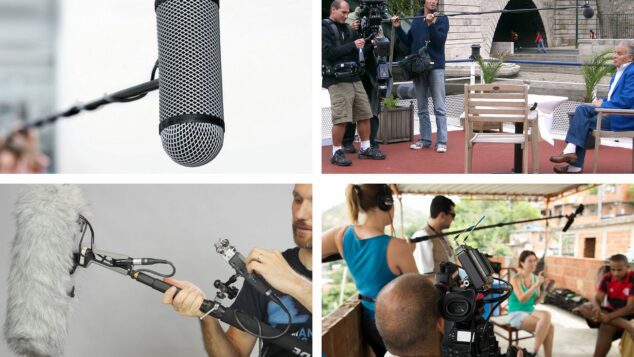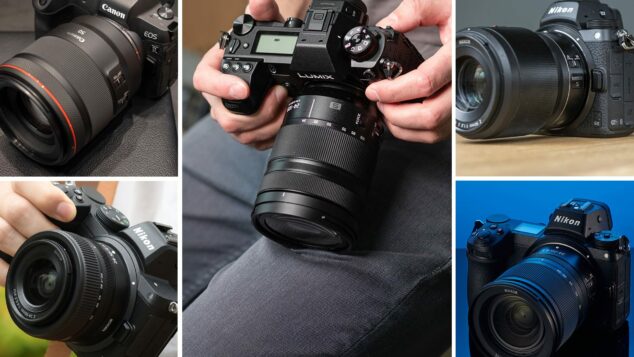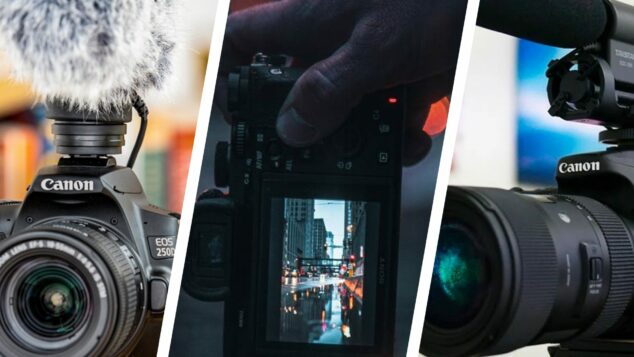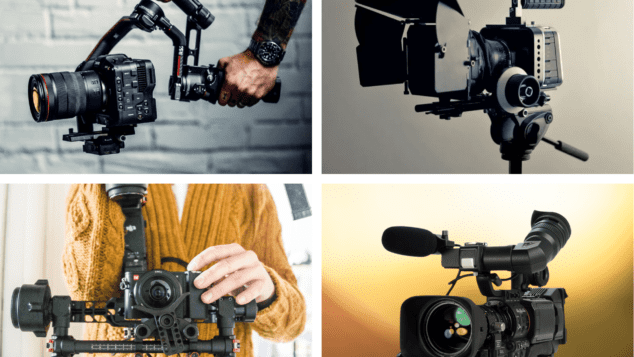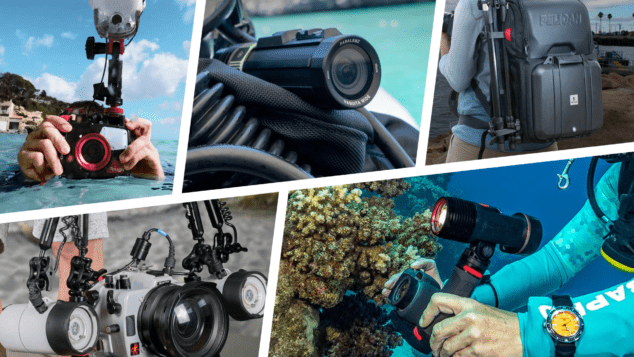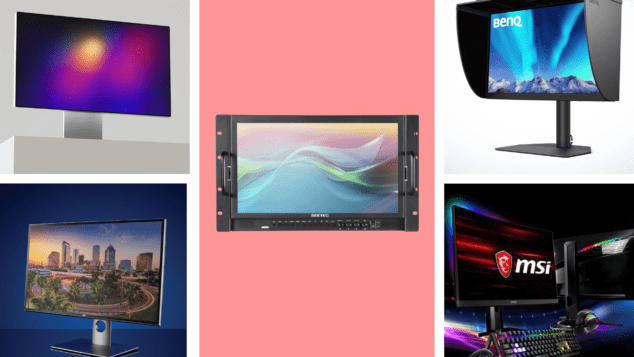In the modern world, we are bombarded with thousands of cameras and hundreds of categories within them. It feels like solving a never-ending puzzle. Don’t worry! We have you covered!
Today, cameras that are devoid of mirrors are preferred, and for good reason. They use the latest photography technology to offer you high resolution, fast shooting, excellent video recording, and connectivity.
Also, mirrorless cameras support interchangeable lenses, which is a big advantage to owning them, allowing you to take quality footage anywhere.
Mirrorless Cameras – An Introduction
Let’s face it, mirrorless cameras are great. It’s a fact we can’t deny. Without a doubt, they are superior to their counterparts, DSLR cameras, because of their advanced qualities.
Compared to a DSLR, a mirrorless camera has better technical features and specifications. It has exceptional connectivity, outstanding video recording, and high-resolution sensors.
That’s just a glimpse of what mirrorless cameras can do.
With that in mind, we know that mirrorless cameras are exceptional, and they certainly deserve their praise.
However, there is a common question asked by many people, “What is the best mirrorless camera amongst all of them.”
It’s a decent question because as of now, many brands make mirrorless cameras. Because of that, it’s difficult to determine which one stands out from the crowd.
If you are new to this field, you may have a hard time trying to figure out the best mirrorless camera. Even if you are a seasoned pro, the process can still be intimidating.
Regardless, I have studied different models of mirrorless cameras.
This article is going to introduce you to a variety of models and show you the best mirrorless camera there is.
Ready?
Best Mirrorless Cameras
Here we have curated a list for you to get you out of the entanglement of having to choose the best mirrorless camera for you:
1. Sony A7R IV
Stunning Resolution and Sensor Performance
Sony’s A7R IV shook the camera industry with its mind-blowing 61-megapixel full-frame sensor, offering a resolution that was unprecedented in its category.
This allows photographers to capture an immense level of detail, making the camera ideal for landscape, architecture, and studio photography where every nuance matters.
The back-illuminated sensor design ensures better low-light performance and reduced noise, even at high ISO settings.
Additionally, the 15-stop dynamic range of this camera ensures that both shadows and highlights are captured with exceptional clarity.
Autofocus and Speed
One of the standout features of the A7R IV is its autofocus system. With 567 phase-detection points and 425 contrast-detection points, it covers approximately 74% of the frame, ensuring that subjects are tracked and kept in focus regardless of their position.
The Real-time Tracking and Real-time Eye AF for both humans and animals are game-changers, providing unparalleled focus accuracy, especially for wildlife and portrait photographers.
With a continuous shooting speed of 10 fps, it’s also capable of capturing fast-moving subjects with precision.
Ergonomics and Build
Sony has taken user feedback into account with the A7R IV, resulting in improved ergonomics compared to its predecessors.
The grip is more substantial and more comfortable, especially for those with larger hands.
Weather-sealing has been enhanced, and the camera is more robustly built, instilling confidence in professionals who often shoot in challenging conditions.
The dual UHS-II SD card slots provide ample storage options and the ability to back up shots in real-time.
The Sony A7R IV is a powerhouse of a camera, combining an ultra-high-resolution sensor with a fast and accurate autofocus system.
Its robust build and improved ergonomics make it a joy to use, and its advanced features cater to professionals who demand the very best from their gear.
While it might be overkill for casual photographers or those who do not need such a high resolution, for professionals and enthusiasts who prioritize image quality, the A7R IV is hard to beat.
It sets a new standard in the full-frame mirrorless category and reaffirms Sony’s commitment to pushing the boundaries of camera technology.
- Bundle Includes: 1 x Sony Alpha a7R IV Mirrorless Digital Camera (Body Only), 2 x SanDisk...
- Moving to an even higher resolution realm, the Sony Alpha a7R IV continues the noteworthy series of...
- Up to 10 fps shooting is possible along with the ability to record UHD 4K30 video, both with support...
- Balancing the imaging merits, the a7R IV also sees an updated physical design with more robust...
- Key Features: 61MP Full-Frame Exmor R BSI CMOS Sensor - BIONZ X Image Processor & Front-End LSI -...
2. Canon EOS R6
Impressive Sensor and Image Quality
The Canon EOS R6 boasts a 20.1-megapixel full-frame CMOS sensor, powered by Canon’s DIGIC X image processor.
While this resolution might not be the highest on the market, the quality of images it produces is undeniable.
The sensor offers an impressive ISO range, ensuring low noise levels even in dimly lit environments.
Combined with Canon’s color science, the R6 delivers vibrant and accurate colors straight out of the camera, making it a solid choice for professionals and enthusiasts who prioritize image quality.
Autofocus and In-Body Stabilization
Canon’s Dual Pixel CMOS AF II system in the EOS R6 is nothing short of revolutionary.
With 1,053 automatically selected AF zones, it provides near-instantaneous autofocus, ensuring subjects are razor-sharp.
The inclusion of animal eye AF, which effectively tracks the eyes of birds, cats, and dogs, is a boon for wildlife photographers.
One of the standout features of the R6 is its 5-axis In-Body Image Stabilization (IBIS), which offers up to 8 stops of shake correction.
This is a game-changer for handheld shooting and video recording, allowing users to shoot at slower shutter speeds without the risk of blur.
Video Capabilities
The EOS R6 excels in the video department, offering 4K recording at up to 60fps, and Full HD at 120fps.
Coupled with the C-log profiles, videographers get ample room for post-production adjustments.
The 10-bit 4:2:2 internal recording ensures that video files retain a high level of detail and dynamic range.
Moreover, the aforementioned IBIS comes in particularly handy for video recording, significantly reducing the need for gimbals or stabilizers during handheld shoots.
The Canon EOS R6 is a testament to Canon’s commitment to the mirrorless market.
While it may not have the highest resolution, it more than makes up for it with its advanced autofocus system, industry-leading stabilization, and robust video capabilities.
It’s a versatile camera that caters to a wide range of photographers and videographers, from those capturing fast action and wildlife to those recording cinematic videos.
The R6 finds its niche as a well-rounded camera that doesn’t compromise on performance, making it a compelling option in the ever-competitive full-frame mirrorless segment.
- Professional photo and video performance 20 3-Megapixel (Plus 80-megapixel high-resolution Jpeg or...
- Rugged splash or freeze proof design durable magnesium alloy body withstands heavy use out in the...
- Class-leading dual image stabilization 5-axis Dual image stabilization corrects all lenses including...
- 4K 60P video 4:2:2 10bit and slow-motion effects silky-smooth 4K 60P recording (QFHD 4K 3840 x...
- Connectivity and ports listen to headphones with a 3.5mm audio port connect to devices with USB 3.0...
BEST MIRRORLESS CAMERA
What Is a Mirrorless Camera?
Mirrorless cameras are a type of digital camera that has been designed to use interchangeable lenses and small sensors.
They offer many advantages over DSLRs, which is why they’re quickly becoming more popular with photographers all over the world.
A mirrorless camera is an excellent choice for anyone who does not want to lug around a heavy DSLR, or would like more flexibility in their photography than what traditional SLRs can provide.
Mirrorless cameras have become increasingly popular in recent years because of how portable they are compared to other types of digital cameras on the market.
3. Nikon Z6 II
Sensor and Image Processing
The Nikon Z6 II is outfitted with a 24.5-megapixel BSI CMOS sensor, an ideal resolution that strikes a balance between detail capture and low-light performance.
The back-illuminated design of the sensor, combined with Nikon’s EXPEED 6 image processor, ensures images are sharp, vibrant, and maintain a broad dynamic range.
The ISO performance, ranging from 100 to 51,200 (expandable to 204,800), means photographers can shoot in a myriad of lighting conditions with confidence, producing images with minimal noise.
Enhanced Autofocus System
One of the main upgrades over its predecessor, the Nikon Z6, is the improved autofocus (AF) system in the Z6 II.
The camera possesses 273 on-sensor phase-detection points, covering a significant portion of the frame.
Nikon has also enhanced the eye-detection AF for both humans and animals, making the Z6 II a preferable choice for portrait and wildlife photographers.
The low-light AF capability, focusing down to -4.5 EV, ensures reliable autofocus even in challenging lighting scenarios.
Performance and Usability
With a shooting speed of up to 14 frames per second, the Z6 II is no slouch in capturing fast action.
This, combined with a larger buffer, allows photographers to shoot extended bursts without missing critical moments.
The dual card slots—a welcomed addition—provide flexibility in storage, offering both CFexpress (Type B)/XQD and UHS-II SD compatibility.
The ergonomics of the camera are thoughtfully designed, with intuitive controls and a comfortable grip, making it a pleasure to use during extended shooting sessions.
The Nikon Z6 II, with its range of improvements over the original Z6, firmly establishes itself as a versatile tool for photographers and videographers alike.
Whether you’re delving into portraiture, wildlife, action, or even landscape photography, the Z6 II provides a robust feature set to cater to diverse needs.
The combination of a refined autofocus system, dual card slots, and enhanced shooting speeds make it a worthy successor in Nikon’s full-frame mirrorless lineup.
For those in search of a well-rounded camera that doesn’t compromise on performance, the Z6 II undoubtedly merits consideration.
- Putting stability in your hands: A huge part of creating great photos or videos is making sure you...
- Performance you can rely on: For any serious image maker, having a tool that can be relied upon to...
- Find the best angle for your story: When chasing the perfect image, versatility is key, so the last...
- When your story needs movement: The modern image maker is blurring the lines between photography and...
- Powerful image manipulation made easy: For over 85 years, Fujifilm has produced photographic films...
4. Fujifilm X-T4
Sensor and Image Processing
The Fujifilm X-T4 houses a 26.1-megapixel X-Trans CMOS 4 sensor coupled with the X-Processor 4 image processing engine.
This sensor and processor combination has been proven to deliver exceptional image quality with remarkable color reproduction, synonymous with Fujifilm’s legacy.
The ISO range of 160 to 12,800, extendable to 80 – 51,200, ensures the X-T4 performs admirably across varying lighting conditions.
The absence of a low-pass filter allows the X-T4 to capture sharp, high-resolution images while minimizing moire.
Autofocus and Performance
The autofocus system of the X-T4 is one of the fastest among APS-C sensor-equipped cameras, with a focus acquisition time of 0.02 seconds.
The camera utilizes a hybrid autofocus system with 425 phase-detection points covering nearly the entire frame, ensuring quick and accurate focus regardless of where the subject is positioned.
The Face/Eye detection feature further enhances the camera’s focusing prowess, especially in portrait photography.
Continuous shooting at 15 frames per second with the mechanical shutter allows for capturing fast-paced action with ease.
In-Body Image Stabilization (IBIS) and Video Capabilities
A notable feature in the X-T4 is its 5-axis in-body image stabilization (IBIS) system, which provides up to 6.5 stops of stabilization, a significant aid in low-light conditions or when using slow shutter speeds.
On the video front, the X-T4 offers 4K recording at up to 60 fps, and Full HD recording at up to 240 fps for slow-motion playback.
The camera’s ability to record 10-bit 4:2:2 externally and 10-bit 4:2:0 internally makes it a robust tool for serious videographers, providing more flexibility in post-production.
The Fujifilm X-T4 stands out as a highly versatile camera catering to a broad spectrum of photographers and videographers.
Its admirable image quality, fast and accurate autofocus, robust in-body image stabilization, and advanced video recording capabilities make it a compelling choice for those seeking a well-rounded camera.
The thoughtful design, with a flip-out touchscreen and a large EVF, adds to the overall appeal, making it a robust, user-friendly tool for both photography and videography.
The X-T4 embodies a significant step forward in Fujifilm’s X series, underlining the brand’s commitment to delivering top-notch performance in a compact, mirrorless form factor.
- Stunning resolution: world’s first 61MP full-frame 35mm back-illuminated Exmore R CMOS Image...
- High speed: up to 10Fps continuous shooting at 61MP with AE/AF tracking; 26. 2MP in APS-C crop mode
- Fast Hybrid Autofocus: 567 Phase detection AF points and 425 contrast AF points to cover more area
- Advanced subject recognition: real-time tracking and real-time eye AF for humans, animals and movies
- Accurate color reproduction: 15-stop dynamic Range at low sensitivities for greater Color accuracy
BEST MIRRORLESS CAMERA
Advantages of Using Mirrorless Cameras
• Easier to use and more versatile than DSLR cameras.
• You can still get a great quality photo with low-light settings when the flash doesn’t work well in an area too dark.
• Mirrorless cameras are smaller and lighter than DSLRs, making them easier to carry on a shoot.
• Mirrorless cameras have fewer buttons and dials than their DSLR counterparts, making it easier for beginners to operate them without having to learn the entire manual by heart.
5. Panasonic Lumix S5
Sensor and Image Processing
The Panasonic Lumix S5 is equipped with a full-frame 24.2-megapixel CMOS sensor, ensuring high-resolution image output and impeccable detail capture.
Its sensor is designed to minimize rolling shutter distortion, which is particularly beneficial when photographing fast-moving subjects or recording video.
Together with the Venus Engine image processor, the S5 delivers exceptional clarity, impressive dynamic range, and accurate color representation.
An expansive ISO range of 100 to 51,200, expandable to 50-204,800, further accentuates its capability to perform optimally even in challenging light conditions.
Autofocus and Performance
Panasonic’s Depth From Defocus (DFD) autofocus technology powers the S5, offering rapid and accurate focus acquisition.
While it might not match the speed of some phase-detection systems, in most real-world scenarios, the S5’s autofocus is more than competent.
With 225 selectable focus points, the camera provides ample coverage and flexibility.
Notably, the S5’s subject tracking and eye/facial detection ensure precision, whether capturing still portraits or moving subjects.
Burst shooting at 7 frames per second ensures that momentary actions are not missed.
Video Capabilities
The Lumix S5 shines brilliantly in the realm of videography.
It offers 4K recording at up to 60 fps and also boasts 10-bit internal recording.
An impressive feature is its ability to shoot 4K at a full pixel readout without binning, ensuring optimal detail and clarity. The V-Log/V-Gamut provides 14+ stops of dynamic range, a boon for post-processing.
Moreover, the S5 also includes features such as Dual Native ISO, which reduces noise in low-light conditions, and the Slow & Quick mode, which offers varying frame rates for creative videography.
Panasonic’s Lumix S5 is an outstanding mirrorless camera that amalgamates the capabilities of a high-end stills camera and a professional video camera.
While it’s compact in size, it doesn’t compromise on features or performance.
Its impressive imaging capabilities, coupled with advanced video features, make it an ideal choice for hybrid shooters.
The camera’s durable build and user-friendly ergonomics further enhance its value proposition.
For those in the market for a versatile, full-frame mirrorless camera that excels both in photography and videography, the Lumix S5 emerges as a compelling choice.
- Every little detail matters. 45.7MP. Powerful AF performance. NIKKOR Z lenses. Intuitive...
- Subject acquisition with speed and precision. 3.3x more buffer capacity than the original Z 7....
- Dual card slots (CFexpress/XQD and UHS-II SD). Flexibility and peace of mind when shooting important...
- Vertical Grip Ready. Now compatible with the new vertical battery grip for those in need of more...
- One mount accepts them all. Compatible with a growing line of NIKKOR Z lenses as well as approx. 360...
6. Olympus OM-D E-M1 Mark III
Sensor and Image Processing
The Olympus OM-D E-M1 Mark III is powered by a 20.4-megapixel Micro Four Thirds sensor, delivering sharp and detailed images that match the needs of most photography genres.
With the TruePic IX image processor on board, the camera ensures quick performance, efficient noise reduction, and robust image quality.
The smaller sensor size also allows for a more compact system, making it a preferred choice for those who prioritize portability without compromising on performance.
The camera excels in reproducing colors, with images that pop and remain true to life.
Autofocus and Performance
With an impressive 121-point all cross-type phase-detection autofocus system, the E-M1 Mark III promises quick and accurate focusing in varied shooting conditions.
The Starry Sky AF mode is particularly remarkable, specifically designed for astrophotography, a testament to Olympus’s innovation.
This camera also boasts high-speed sequential shooting capabilities, allowing users to capture action at 18 frames per second with AF/AE tracking, ensuring you never miss a crucial moment.
In-Camera Stabilization
A standout feature of the E-M1 Mark III is its in-body 5-axis image stabilization system, which offers up to 7.5 stops of compensation when paired with compatible lenses.
This advanced stabilization is invaluable for hand-held shooting in low-light conditions and provides significant advantages for video recording.
Whether you’re capturing stills or video, the robust stabilization ensures that camera shake is minimized, delivering crisp and clear results without the need for a tripod.
The Olympus OM-D E-M1 Mark III stands out in the crowded mirrorless market with its unique features tailored for specific photography needs, like the Starry Sky AF.
Its robust build, advanced stabilization system, and dependable autofocus make it a solid choice for both amateur and professional photographers alike.
While it may not boast the larger sensor of some competitors, it more than compensates with innovative features and compact design.
For those who value a mix of portability and performance, the E-M1 Mark III should undoubtedly be on the consideration list.
- High Image Quality featuring a New 20 Megapixel Full-frame CMOS Sensor.
- DIGIC X Image Processor with an ISO range of 100-102400; Expandable to 204800.
- High-speed continuous shooting of up to 12 fps with Mechanical Shutter and up to 20 fps electronic...
- Dual pixel CMOS AF covering approx. 100% area with 1,053 AF areas.
- Subject tracking of people and animals using deep learning technology.
7. Sony A6400
Sensor and Image Quality
The Sony A6400 comes equipped with a 24.2-megapixel APS-C CMOS sensor and is paired with Sony’s latest BIONZ X image processor.
This combination ensures high-resolution images with a broad dynamic range, excellent clarity, and reduced noise, especially in low-light situations.
The ISO range, stretching from 100 to 32,000 and expandable to 102,400, offers versatile shooting in various lighting conditions.
The A6400 renders colors with vibrancy and accuracy, ensuring images that are true to life and pleasing to the eye.
Autofocus Capabilities
One of the defining features of the Sony A6400 is its lightning-fast autofocus system.
With 425 phase-detection points and 425 contrast-detection points, the camera boasts a coverage of 84% of the image area, ensuring that subjects remain in sharp focus.
The Real-time Eye AF and Real-time Tracking technologies are particularly commendable, locking onto subjects with precision and maintaining focus even when the subject is in motion.
For portrait enthusiasts, the Eye AF for animals is an added advantage, making pet photography a delight.
Video and Vlogging Potential
The A6400 excels in the video department, offering 4K video recording with full pixel readout and no pixel binning.
This capability ensures detailed and clear footage, making it an attractive option for videographers and content creators.
The flip-up touchscreen LCD is a boon for vloggers, allowing for easy self-framing.
Additionally, with features like S-Log2 and S-Log3, advanced users can extract maximum dynamic range from their footage, making post-production grading a breeze.
The Sony A6400 stands as a testament to Sony’s commitment to merging powerful features in a compact body.
With its robust autofocus system, impressive image quality, and video capabilities, it caters to photographers and videographers alike.
Whether you’re a budding content creator, a travel enthusiast looking for a lightweight companion, or a professional in need of a reliable secondary camera, the A6400 is a compelling option that delivers exceptional value for its price point.
- Compact, lightweight and durably constructed mirrorless camera
- First DX-format mirrorless camera to use a large 55 millimeter lens mount, offering advantages in...
- 20.9 MP sensor with robust 4K UHD video features
- Built-in Wi-Fi and Bluetooth for simple pairing to a smartphone.
- "Selfie" flip down touch LCD screen, great for self-portraits and vlogging.
8. Canon EOS M6 Mark II
Sensor and Image Quality
The Canon EOS M6 Mark II boasts a 32.5-megapixel APS-C CMOS sensor, making it one of the highest-resolution crop sensor cameras in Canon’s lineup.
This ensures that images captured have a high level of detail, clarity, and sharpness.
Paired with Canon’s DIGIC 8 image processor, this camera offers a commendable ISO range of 100-25,600, which can be expanded up to 51,200.
The result is crisp images with reduced noise, even in challenging lighting conditions.
Colors are vibrant and true to life, ensuring that each shot resonates with Canon’s signature color science.
Autofocus and Speed
The EOS M6 Mark II features an impressive Dual Pixel CMOS AF system, ensuring quick and accurate focus acquisition.
With 5,481 selectable focus positions, photographers have a wide array to choose from, ensuring that the subject remains tack sharp.
Additionally, the Eye Detection AF is a valuable tool for portraiture, locking onto the eyes of the subject, guaranteeing striking portraits every time.
Speed is another area where this camera excels; with a continuous shooting rate of 14 fps and up to 30 fps in RAW burst mode, capturing fleeting moments becomes a breeze.
Portability and Design
Designed with the on-the-go photographer in mind, the M6 Mark II is compact and lightweight, making it an ideal companion for travel and street photography.
The camera does not feature a built-in viewfinder, which may be a downside for some, but Canon offers an optional detachable EVF for those who prefer it.
The tilting touchscreen LCD is responsive and offers intuitive control, simplifying menu navigation and ensuring that shots are framed perfectly.
The Canon EOS M6 Mark II merges high-resolution imaging capabilities with a compact design, making it a versatile tool for photographers of all levels.
Whether you’re delving into street photography, capturing landscapes, or shooting portraits, this camera delivers consistently high performance.
Its swift autofocus system, impressive continuous shooting rate, and user-friendly design make it a worthy contender in the mirrorless segment.
For those in search of a compact yet powerful camera that doesn’t compromise on image quality, the M6 Mark II is undoubtedly a top pick.
- World’s fastest AF at 0.02 sec. W/ real-time AF & Object tracking
- Wide 425-phase/425-contrast detection AF points over 84% of sensor
- 24.2MP APS-C Exmor sensor w/ front end LSI and ISO up to 51,200
- Up to 11fps continuous shooting5 at 24.2MP RAW w/ AF/AE tracking
- Real-time AF Tracking, Real-time Eye AF for human and animal
9. Nikon Z50
Sensor and Image Quality
The Nikon Z50, a pivotal release in Nikon’s mirrorless lineup, features a 20.9-megapixel APS-C DX-format CMOS sensor.
This sensor, paired with Nikon’s EXPEED 6 image processing engine, ensures a blend of high-resolution images and superior noise reduction.
With an ISO range of 100-51,200, the Z50 offers commendable low-light performance.
Colors produced are vibrant and accurate, with images retaining sharpness and detail.
Furthermore, the camera’s in-body image stabilization aids in reducing the chances of blurry shots, ensuring clear images even at slower shutter speeds.
Autofocus and Speed
The Z50 is equipped with a 209-point hybrid autofocus system that covers approximately 90% of the frame.
This broad coverage ensures accurate and swift focus acquisition, be it landscapes or moving subjects.
Its Eye-Detection AF is particularly impressive, proving to be a reliable feature for portrait photographers.
Speed-wise, the Z50 can shoot continuously at 11 fps with full autofocus and auto-exposure, ensuring that action and candid moments are never missed.
Ergonomics and Design
Nikon’s dedication to ergonomic design is evident in the Z50. Despite its compact size, the camera is comfortable to hold, with controls intelligently placed for ease of use.
The 3.2-inch tilting touchscreen LCD is versatile, catering to vloggers and selfie enthusiasts with its flip-down design.
The electronic viewfinder is sharp and provides a clear view, assisting photographers in composing their shots accurately.
The robust magnesium alloy body, weather-sealed to some extent, ensures durability even in challenging conditions.
The Nikon Z50 stands out as a competent mid-range mirrorless camera, delivering a combination of performance, portability, and price.
It addresses the needs of both budding photographers and seasoned professionals looking for a compact backup.
With its advanced autofocus system, solid build, and the ability to produce high-quality images, the Z50 is a testament to Nikon’s commitment to catering to the mirrorless market.
It’s a camera that effortlessly merges functionality with form, making it a strong choice for those venturing into the world of mirrorless photography.
- High Image Quality featuring a New 45 Megapixel Full-frame CMOS Sensor..Working Temperature Range :...
- DIGIC X Image Processor with an ISO range of 100-51200; Expandable to 102400x1.
- High-speed continuous shooting of up to 12 fps with Mechanical Shutter and up to 20 fps electronic...
- Dual pixel CMOS AF covering approx. 100% area with 1,053 AF areas.
- Subject tracking of people and animals using deep learning technology.
10. Panasonic Lumix GH5S
Sensor and Video Capabilities
The Lumix GH5S, a standout in Panasonic’s GH series, is often celebrated for its video-centric features.
It sports a 10.2-megapixel Digital Live MOS sensor that, while appearing low in resolution, is designed to excel in low-light conditions.
One of its crowning achievements is its ability to record Cinema 4K (4096×2160) video at 60p with 10-bit internal recording.
The multi-aspect sensor gives users greater flexibility in choosing aspect ratios without changes in focal length. Color graders will appreciate the V-LogL profile that offers increased dynamic range and flexibility in post-production.
High Frame Rate and Connectivity
Aimed at professional videographers, the GH5S provides high frame-rate recording.
It can capture Full HD footage at up to 240fps, allowing for smooth slow-motion sequences.
For those concerned about audio, the camera has a Timecode In/Out compatibility, making it easier to synchronize multiple cameras during post-production.
The GH5S also boasts of dual SD card slots, both UHS-II compatible, ensuring uninterrupted recording.
Additionally, the full-sized HDMI port is a considerate addition, allowing the use of external monitors or recorders without the need for adapters.
Build and Design
Reflecting its professional intentions, the GH5S’s build quality is top-notch.
The magnesium alloy body is both durable and weather-sealed against dust and splashes.
Its 3.2-inch touchscreen is clear and responsive, and the OLED electronic viewfinder ensures accurate shot composition.
The camera’s layout is intuitive, with customizable buttons enhancing its usability.
Unlike its sibling, the GH5, the GH5S forgoes in-body image stabilization, a decision Panasonic made to maximize video quality and reduce the potential for wobbles during fixed rig setups.
The Panasonic Lumix GH5S reaffirms Panasonic’s commitment to videographers by offering features that are typically found in more expensive cinema cameras.
Its low-light capabilities, combined with high frame rate recording and professional-level connectivity options, make it a compelling choice for filmmakers.
While it might not be the ideal pick for photographers due to the lower resolution sensor, it unequivocally shines in the video domain.
For content creators and videographers, the GH5S is a powerful tool that delivers without breaking the bank.
- Large, full frame Z mount for Revolutionary optical performance
- Nikon-designed 24. 5MP backside illuminated image sensor
- 273-Point on-sensor Phase detect AF system
- Up to 12 fps; 4K Ultra-HD video; 6K time-lapse; 1080P/120Fps slow motion
- Compatible with NIKKOR Z lenses, over 360 F-mount NIKKOR lenses
11. Fujifilm X-S10
Design and Ergonomics
The Fujifilm X-S10 boasts a compact design, making it a suitable choice for those who value portability without compromising on performance.
Unlike many of Fujifilm’s other X-series cameras that have a vintage, rangefinder aesthetic, the X-S10 opts for a more modern DSLR-like appearance.
The deep handgrip is noteworthy, ensuring the camera sits comfortably even during prolonged usage.
Made with a magnesium alloy, it strikes a balance between durability and weight, ensuring it remains light but resilient.
Performance and Image Quality
Under the hood, the X-S10 is equipped with a 26.1-megapixel X-Trans IV APS-C sensor, ensuring sharp and vibrant shots.
It inherits the renowned color science Fujifilm is known for, with the Film Simulation modes standing out, allowing users to emulate classic Fujifilm film stocks.
The camera’s autofocus is both speedy and reliable, with face and eye detection features adding to its precision.
In terms of video, it can capture 4K at up to 30fps and Full HD at 240fps, catering to both casual vloggers and more dedicated videographers.
In-body Image Stabilization (IBIS)
A standout feature of the X-S10 is its in-body image stabilization (IBIS).
It’s impressive to find such a feature in a camera of this size and price point.
Offering up to 6 stops of stabilization, it considerably reduces the chances of camera shake, ensuring clearer shots at slower shutter speeds or while using telephoto lenses.
This is especially beneficial for video work, granting smoother, more professional-looking footage when shooting handheld.
The Fujifilm X-S10 manages to pack a punch in its compact form.
It’s an excellent option for those transitioning from beginner cameras or even for experienced shooters looking for a capable secondary camera.
Its modern design, coupled with impressive features like IBIS and the iconic Film Simulation modes, make it a standout in its category.
For photographers and videographers seeking a combination of portability, performance, and value, the X-S10 is undoubtedly a compelling consideration.
- 20 MP Live MOS Sensor
- Always-on connection and background connection via Bluetooth & OI Share Smartphone app
- Flip-down monitor and dedicated Selfie mode. Selfie mode automatically turns on when monitor is...
- In-Body 5-Axis Image Stabilization capable of 4.5 shutter speed steps of compensation
- 16 Art Filters (31 types). Includes new Instant Film for a nostalgic feel
12. Sony A7C
Compact Full-frame Brilliance
The Sony A7C takes the essence of what makes Sony’s full-frame mirrorless cameras so sought after and compacts it into a smaller, more portable body.
It’s one of the tiniest full-frame cameras with in-body image stabilization (IBIS), making it an appealing choice for travelers and street photographers.
The build quality, though lightweight, feels robust, ensuring durability. The flip-out touchscreen is a handy addition, especially for vloggers or those who often shoot from difficult angles.
Performance and Image Quality
Armed with a 24.2-megapixel BSI-CMOS sensor, the A7C delivers images that are both detailed and rich in color.
It uses the same Bionz X processor found in the A7 III, ensuring that it can handle fast-paced scenarios, such as sports or wildlife photography, with ease.
The ISO range is also commendable, allowing for flexibility in various lighting conditions.
On the video front, the A7C can record 4K footage at up to 30fps and Full HD at 120fps, with the colors and details being impressively sharp.
Its autofocus system is laudable, with the Real-time Tracking and Real-time Eye AF consistently ensuring subjects remain in sharp focus.
Enhanced Usability Features
Sony seems to have made a conscious effort to ensure the A7C caters to a broader range of photographers and videographers.
The aforementioned fully articulating touchscreen allows for more versatile shooting and aids in self-recording scenarios.
Moreover, the user interface, which has been a point of contention in older Sony models, feels more intuitive in the A7C.
The camera also offers Wi-Fi and Bluetooth connectivity, simplifying the process of transferring images or remotely controlling the camera.
Sony’s A7C is an intriguing proposition for those in the market for a compact full-frame camera.
While it retains many of the key features and performance metrics of its bigger siblings, it offers them in a form factor that is both travel-friendly and versatile.
The blend of top-notch image quality, reliable performance, and enhanced usability features, like the flip-out screen and improved UI, make the A7C a worthy consideration for both enthusiasts and professionals alike.
- Advanced Image Sensor Technology: The 26.1MP BSI APS-C X-Trans CMOS 4 image sensor and X-Processor 4...
- Accurate Auto-Focus Tracking and Face Detection: he new X-Processor 4 Quad Core-CPU offers fast and...
- Superior video and image effects: The ex-t30 offers the ability to record 4K video at 30 frames per...
- Intuitive Design with Comfortable Controls: Offers 3. 0-inch touch LCD with 2-way tilting and...
- Next-Gen Wireless Connectivity: Built-in Wi-Fi and Bluetooth V.4.2 offer digital communication with...
13. Canon EOS R5
Moving forward in our quest for the best mirrorless camera, we can’t overlook the powerhouse that is the Canon EOS R5.
Undeniably a leader in the field, this camera has set a new bar for what filmmakers can expect from a portable setup.
With its ability to shoot 8K RAW video up to 30fps and 4K at 120fps, the EOS R5 is a game-changer for creatives demanding high-resolution output for projects that range from indie films to high-budget commercials.
The detail retained in video mode is simply astonishing, letting us push our storytelling to new heights.
One of the most striking features is the R5’s in-body image stabilization (IBIS), which – when combined with the optical stabilization of RF lenses – provides up to 8 stops of shake correction.
This has massive implications for those of us who often shoot handheld or in challenging conditions.
Here’s what else the EOS R5 has to offer filmmakers:
- 45-megapixel full-frame CMOS sensor that delivers exceptional image quality and color reproduction.
- Dual Pixel CMOS AF system covering approximately 100% of the frame with 1,053 AF areas, enabling precise focus even in dynamic shooting scenarios.
- Dual card slots supporting CFexpress and SD UHS-II cards, offering the flexibility in file management and ensuring we never miss a shot due to card fill-up.
- Robust weather-sealing that ensures we can continue shooting even when the weather turns sour.
Not just a boon for videographers, the Canon EOS R5 also caters to hybrid shooters.
Its still photography capabilities are nothing short of professional level, with a fast continuous shooting speed of up to 20 fps using the silent electronic shutter.
While all these technical advancements are compelling, it’s important we discuss usability.
Fortunately, the EOS R5 boasts a well-designed body with an intuitive control layout and a responsive touchscreen interface making it a joy to use in the field.
Whether we’re capturing the subtle nuances of human emotions or the chaotic beauty of nature, the EOS R5 stands ready as a tool that doesn’t just keep up with our creative demands but inspires new perspectives.
14. Nikon Z7 II
The Nikon Z7 II stands out as a remarkable contender in our roundup.
Equipped with a 45.7-megapixel BSI CMOS sensor and dual EXPEED 6 image processors, it offers filmmakers a potent combination of high-resolution imaging and smooth performance.
Handling both stills and video with ease, the Z7 II shoots 4K video at 60fps.
It’s also known for its remarkable low-light capabilities which are crucial when capturing scenes in challenging lighting conditions.
Coupled with N-log and 10-bit HDMI output, the camera provides great flexibility in post-production.
Our experience with the Z7 II has revealed its robust build quality – essential for the rigors of filmmaking.
The camera’s weather-sealed design ensures it can withstand the elements, making it reliable for shooting in a range of environments.
One of its standout features is the improved autofocus system.
The Z7 II boasts a 493-point phase-detect AF system, which not only covers a wide area of the frame but also allows for quick and accurate subject tracking.
Here’s a brief overview of its core capabilities:
- 45.7MP resolution – High enough for detailed shots and cropping in post.
- 4K video at 60fps – Offering exceptional video quality and slow-motion capabilities.
- Dual card slots – For flexible storage options and backup.
Its user-friendly interface is a boon for filmmakers who need to adjust settings quickly on set.
Users benefit from the intuitive layout and the responsive rear touchscreen which makes navigating through menus and selecting focus points a breeze.
Although the Z7 II is not the first choice when compact size is
With the addition of in-body stabilization, you can expect crisp, shake-free footage even when shooting handheld.
This is another reason why we find the Nikon Z7 II to be a formidable ally in our creative endeavors.
Mirrorless Camera – Buying Considerations
Which camera without a mirror works best for you? Which one do you purchase? Some of these questions might trouble you when it’s time to take action.
Don’t worry, we’re here to help you make this decision and using our buyer’s guide, you can decide which camera will be best for you.
Best In Megapixels
High megapixels always lead to high-quality detailed results and if you are on a hunt for that and money’s no matter to you then Sony A7RIV is the best for you.
It comes with a 61-megapixel full-frame sensor and will help you achieve the desired outcomes.
Best For Travel
Unsure, of what could be the best camera to take with you while traveling. The Fujifilm X-E4 is the best in this regard.
Best Budget-Friendly Option
It is important and often the priority of people to get a good camera without breaking their bank and that is when friendly wallet cameras become the rescuers.
The Nikon Z50 and Fujifilm X-T30 are among the most affordable cameras you can get.
Best In Handling
Cameras with great handling include Nikon Z50, Nikon Z7 II, and Panasonic Lumix G9. There is not much to choose between them with regards to handling and they all enhance your focus while shooting.
Best In Video Quality
Good video quality is important for filming vlogs and other video content types. For this purpose, we have Nikon Z6, Fujifilm X-T30, Panasonic Lumix G9, and Fujifilm X-E4. All of them will tick the boxes of great video quality.
Best Autofocus System
Fast, high-performance Autofocus cameras include the Nikon Z7 II, Sony A6100, and Fujifilm X-T30.
Best For Ease-Of-Use
If you are a beginner and just know the basics of using a camera, easy-to-use cameras are best for you before you learn to use the more sophisticated features. One of the best cameras in this regard is the Sony A1600.
Best for IBIS (In-Body Image Stabilization)
This is a must-have feature for shooting videos and photos and you wouldn’t want to get it wrong. The Fujifilm X-T4 and Olympus OM-D-EM10 Mark IV will help you achieve impressive stabilization of your body image.
Best Mirrorless Cameras – Wrapping Up
Undoubtedly, it’s important to upgrade your camera to deliver high-value content that will get you the job you want.
A mirrorless camera will give you a healthy edge over your peers who aren’t using one such mirrorless camera.
However, getting a camera requires giving your pocket a significant shake and you wouldn’t want to end up wasting the money you spent.
We hope that the above product reviews and buying guide have enriched you with the correct know-how to decide on which is the best mirrorless camera according to your needs. It’s time for you to purchase the best mirrorless camera now!
So what are you waiting for? We hope our guide to the best mirrorless camera has aided you in making a purchase decision.
Whether you’re buying a camera for your next vacation or you’re upgrading your video company from DSLRs to mirrorless cameras, we wish you luck in whatever you do!
We have Gear Buyer’s Guides on every type of Filmmaking Equipment!
-
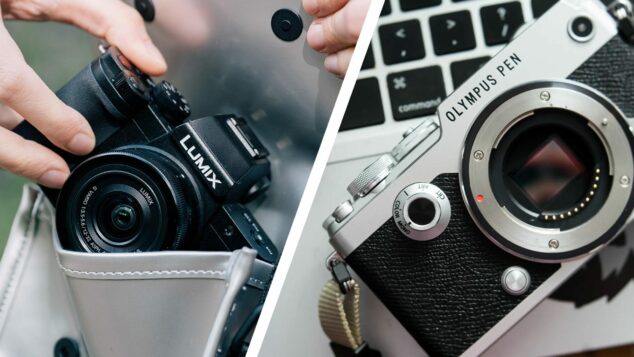 anemptytextlline
anemptytextlline -
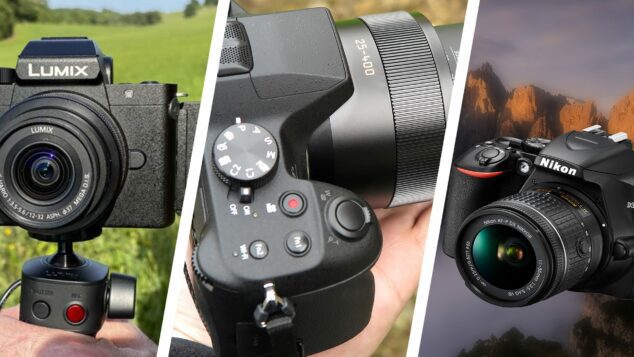 anemptytextlline
anemptytextlline -
 anemptytextlline
anemptytextlline -
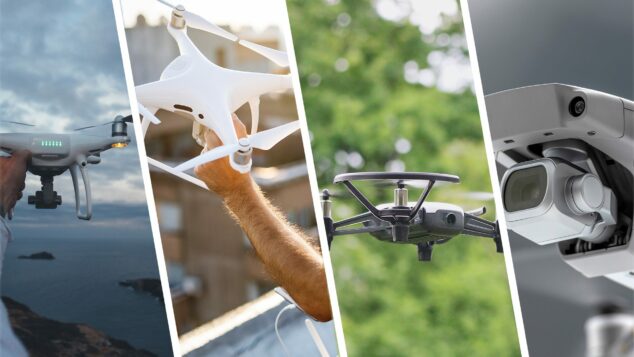 anemptytextlline
anemptytextlline

















